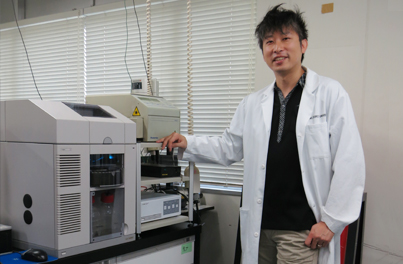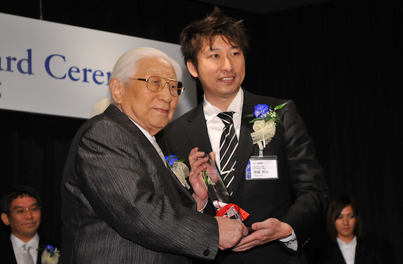

Electrophoresis for determination of ultratrace heavy metal ions in radioactive wastes and environmental microbes using novel fluorescent probes
Graduate School of Science and Engineering, Saitama University
*The organization and the title are those when awarded
Abstract
- 日本語
- English
現在の分析技術をもってしても,多量の妨害物質を含む試料中の微量物質の検出や化学物質のスペシエーション(化学種同定)などは困難な課題となっている。本研究では,水溶液中の重金属イオンをターゲットとして,超高感度・迅速・簡便・少試料量・省エネルギー・ロバストな電気泳動-蛍光検出法を構築した。これを達成するために,重金属イオンの錯体化による蛍光ラベル化可能な配位子群(蛍光プローブ)を開発し,その金属錯体を高度分離する電気泳動分離場も併せて開発した。これによって,環境水,生体試料,使用済み核燃料中の重金属イオンの超高感度検出法および生体試料中のタンパク結合型金属イオンのスペシエーション法の開発に成功した。
Ultratrace detection and speciation of trace heavy metal ions in small-volume samples containing a lot of interfering substances with low energy cost, rapidity and robustness is very difficult. In this study, a series of capillary and gel electrophoresis-fluorescence detection methods was developed using novel fluorescent metal probes, which fluorescently labeled target metal ions via complexing. The metal-probe complexes were successfully separated from the free probe and interfering ions, to be detected in ppt levels. Using these probes, determination methods for heavy metal ions in environmental, biological and nuclear spent fuel samples, and a speciation method for protein-bound copper ions in human serum were established.
Research summary
Electrophoresis is a separation method that utilizes the difference in ionic mobility in an electric field.
This method is widely used for separation analysis by combining with detectors such as fluorescence detector and optical absorption detector and others.
No method, however, provides high sensitivity sufficient for heavy metal ions in environmental water.
Dr. Saito has developed novel fluorescent probes that strongly bind with target heavy metal ions, which show no quenching of emission during binding.
Then he developed new electrophoresis methods that highly separate and detect the emissive metal-probe species.
In his method, hazardous heavy metal ions such as lead and actinide* ions can be analyzed with ultra-high sensitivity on the order of ppt, with only a small amount of sample.
It is expected to be applied to heavy metal ion analysis in water samples including radioactive-contaminated waste water.
* Heavy metal elements with the atomic numbers from 89 to 103, including radioactive uranium and plutonium, are categorized as "actinide" series.



